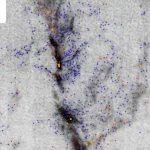(Press-News.org) Snow cover in the Alps has been melting almost three days earlier per decade since the 1960s. This trend is temperature-related and cannot be compensated by heavier snowfall. By the end of the century, snow cover at 2,500 meters could disappear a month earlier than today, as simulations by environmental scientists at the University of Basel demonstrate.
Global warming demands huge adjustments in tourism, hydropower generation and agriculture in alpine areas. But the fauna and flora also have to adapt to rising temperatures. By the end of the century, continuous snow cover for 30 days below 1,600 meters is expected to be a rare occurrence. "Snow cover protects alpine plants from frost and the growing season begins after the snowmelt. Changes in the snowmelt have a very strong influence on this period," explains Dr. Maria Vorkauf of the Department of Environmental Sciences at the University of Basel. She researched alpine plant physiology intensively for her doctoral dissertation.
New measurements at high elevations
In a new study, Vorkauf and colleagues at the University of Basel and the Institute for Snow and Avalanche Research investigated how the date of snowmelt has changed in recent decades and what shifts can be expected by the end of the 21st century. For a long time, only a few measurement series of snow cover at high elevations were available, as measurements were usually only made near inhabited regions below 2,000 meters. This changed with the IMIS measurement network, which went into operation in 2000. It automatically records the snow depth between 2,000 and 3,000 meters every half hour. The researchers combined this data with measurement series from 23 lower-lying stations with manual measurements going back to at least 1958.
Analysis of the data showed that between 1958 and 2019, snow cover between 1,000 and 2,500 meters melted an average of 2.8 days earlier every decade. This shift was not linear, but was particularly strong in the late 1980s and early 1990s. This corresponds to strong temperature increases in this time period that have been verified by climate research.
Simulation of the alpine future
Based on the analyzed measurements, the researchers developed a model that makes it possible to forecast the future development of alpine snow cover. They combined their data with the latest climate scenarios for Switzerland. If greenhouse gas emissions continue to rise as they have so far, without consistent climate protection measures, the date of snowmelt in the last third of the 21st century is likely to move forward by six days per decade. This means that by the end of the century, snowmelt at 2,500 meters elevation would occur about one month earlier than today.
The research also showed that the earlier snowmelt at high elevations cannot be compensated for by greater precipitation in the winter, as is predicted by climate models for Switzerland. "As soon as the three-week running mean of daily air temperatures exceeds 5 °C, snow melts relatively quickly," explains Vorkauf. "At high elevations in particular, temperature is much more important than the depth of the snow cover."
Earlier flowering and higher frost risk
In the future, the early snowmelt could extend the growing season of alpine plants by about a third. As is known from studies of other alpine plant species, an earlier start to the growing season leads to fewer flowers, less leaf growth and a lower survival rate due to the higher risk of frost. "Some species such as the Alpine sedge, which is typical of alpine grasslands, will grow and flower earlier because of the early snowmelt," says Vorkauf.
Although temperatures in alpine areas are rising faster, alpine plant species are not more strongly affected by climate change than those at other elevations. "The topography and exposure of alpine terrain creates very diverse microclimates on a small scale. Within these, plants can retreat over short distances at the same elevation," Vorkauf explains. As a result, alpine plant species do not have to "flee" to the heights, as is often assumed.
INFORMATION:
If you are exposed to silica (quartz) dust at work - e.g. from working with concrete and granite - you have a greater risk of certain types of rheumatic disease. This is shown by results from Aarhus University and Aarhus University Hospital, which have just been published in the International Journal of Epidemiology.
Exposure to silica dust at work, which is the case especially at workplaces within construction and industry, may lead to autoimmune rheumatic diseases. Photo: Unsplash.
Exposure to silica dust at work, which is the case especially at workplaces within construction and industry, may lead to autoimmune rheumatic diseases. Photo: Unsplash.
As the research results from Aarhus University show, exposure to ...
The leading newspapers in two nuclear waste management forerunner countries, Finland and France, fulfil their "watchdog" roles in highly distinct ways. The Finnish Helsingin Sanomat (HS) tends to reproduce government and industry framings, whereas Le Monde cherishes its role as an independent critic of the powers that be. These differences reflect distinct cultural, political and media traditions in the two countries.
"The critical watchdog model works in a liberal democracy such as the French, based on mistrust towards the governing elites. But would it backfire in Finland by undermining the very institutional trust that the Nordic democracies have been built upon throughout history?" asks the first author of the article, Research Fellow Markku Lehtonen from the Department of Humanities ...
A new study has shown that underweight and overweight women are at a significantly higher risk of experiencing recurrent miscarriages compared to those of average weight.
A research team led by the University of Southampton assessed the link between women's lifestyle and risk of recurrent pregnancy loss, defined as women having two or more consecutive early miscarriages. The systematic review and meta-analysis study has been published in the journal Scientific Reports.
Miscarriage is the most common complication of early pregnancy, affecting 15 - 20% of all pregnancies. Recurrent pregnancy loss is a complex disease and although often attributed to numerous medical factors and lifestyle influences, the cause is deemed "unexplained" ...
Tokyo, Japan - Leukemias are debilitating cancers of the hematopoietic or blood-forming cells of the bone marrow. Now, researchers at Tokyo Medical and Dental University (TMDU) describe an ingenious strategy against chronic myelomonocytic leukemia (CMML) wherein an antibody-drug conjugate (ADC) comprising a cytotoxic drug payload linked to an antibody that selectively targets specific cell lines effectively blocks malignant cell proliferation at source.
Hematopoietic stem and progenitor cells (HSPCs) continually differentiate into the entire panoply of blood cells, as many as 500 ...
Since fast radio bursts (FRBs) were first discovered over a decade ago, scientists have puzzled over what could be generating these intense flashes of radio waves from outside of our galaxy. In a gradual process of elimination, the field of possible explanations has narrowed as new pieces of information are gathered about FRBs - how long they last, the frequencies of the radio waves detected, and so on.
Now, a team led by McGill University researchers and members of Canada's CHIME Fast Radio Burst collaboration has established that FRBs include radio waves at frequencies lower than ever detected before, a discovery that redraws the boundaries for theoretical astrophysicists trying to put their finger on the source of FRBs.
"We ...
WHAT:
The experimental antiviral drug MK-4482 significantly decreased levels of virus and disease damage in the lungs of hamsters treated for SARS-CoV-2 infection, according to a new study from National Institutes of Health scientists. SARS-CoV-2 is the virus that causes COVID-19. MK-4482, delivered orally, is now in human clinical trials. Remdesivir, an antiviral drug already approved by the U.S. Food and Drug Administration for use against COVID-19, must be provided intravenously, making its use primarily limited to clinical settings.
In their study, published in the journal ...
Artificial intelligence (AI) has sped up the process of detecting flooded buildings immediately after a large-scale flood, allowing emergency personnel to direct their efforts efficiently. Now, a research group from Tohoku University has created a machine learning (ML) model that uses news media photos to identify flooded buildings accurately within 24 hours of the disaster.
Their research was published in the journal Remote Sensing on April 5, 2021.
"Our model demonstrates how the rapid reporting of news media can speed up and increase the accuracy of damage mapping activities, accelerating ...
Collaborative research of the University of Jyvaskyla and Natural Research Institute Finland presents new evidence of the effects of enriched rearing on well-being of aquaculture fishes. The research demonstrates that stone enrichments that have been previously conditioned in lake water significantly improve survival of fish compared to clean stones. Also a higher number of stones has a similar positive effect. The results have practical implications for prevention of aquaculture diseases. The study was published in Antibiotics in March 2021.
The volume of aquaculture is continuously increasing. Parasitic diseases represent a significant threat to farmed fishes and ecological solutions to minimize use of medication are being sought.
Enriched rearing, where rearing tanks ...
A survey of star formation activity in the Orion Nebula Cluster found similar mass distributions for newborn stars and dense gas cores, which may evolve into stars. Counterintuitively, this means that the amount of gas a core accretes as it develops, and not the initial mass of the core, is the key factor in deciding the final mass of the produced star.
The Universe is populated with stars of various masses. Dense cores in clouds of interstellar gas collapse under their own gravity to form stars, but what determines the final mass of the star remains an ...
Academic medical centers continuously strive to enhance patient care. One of the major mechanisms to improve patient health outcomes is through translational research - bringing research breakthroughs from the lab to patients via clinical trials. Making clinical trials more efficient, and ultimately more successful, would significantly advance patient care. However, fragmentation of the relevant data necessary to implement improvements to translational science is a significant barrier.
While some bioinformatic tools have attempted to address this problem, they often lacked the ability to assess the efficiency of translational science. ...







